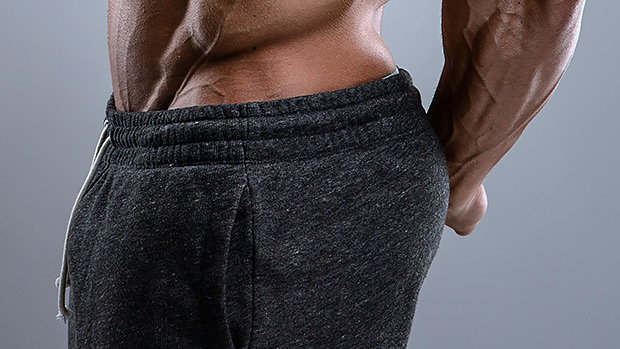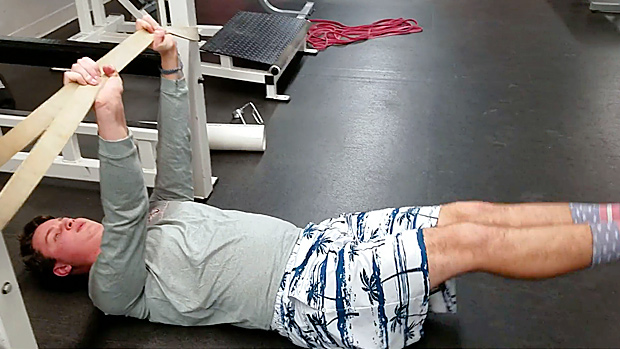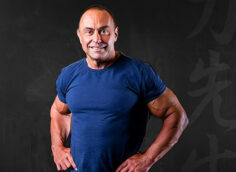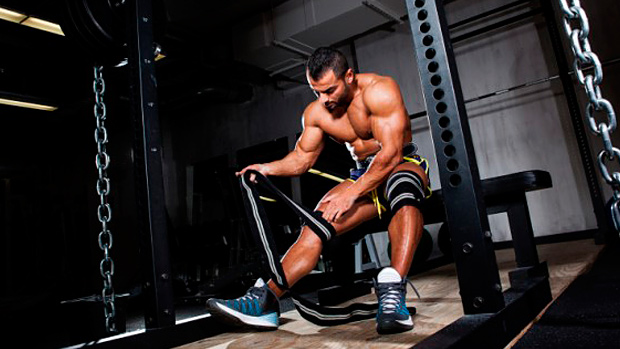Most lifters spend the bulk of their time hammering away at squats and deadlifts. Those are my favorites as well, but it's important to add in accessory work to complement those bigger, compound moves.
You'll likely need to get out of the sagittal plane of motion (forward and back) by incorporating some frontal plane (side-to-side) exercises. Long-term durability in your hips and knees is enhanced by strengthening the smaller, less discussed muscles, such as the adductors (groin muscles) in the inner thigh.
So let's get into a few frontal plane exercises that'll strengthen those forgotten muscles.
There's a good amount of evidence on the benefits of this style of plank. It's an isometric exercise that can actually target the groin.
For this variation, your contact point on the bench is the inside of your mid-calf. Press that top leg down hard to keep it as straight as possible throughout. The job of the bottom knee is to do an active knee drive for reps.
This knee drive addition promotes an even greater challenge for the groin muscles of the top leg and you'll feel it throughout its isometric hold.
How to Do It
- Place your mid-calf of your top leg on the bench and keep it straight throughout the exercise.
- Prop your body up into a side plank with sturdy shoulders.
- Drive the bottom knee up and down for reps.
Use the same exact set up as you did in the previous version. But this time you'll want to use the insole of your top foot as the contact point. This means you'll have a longer lever to deal with, which increases the challenge. If that wasn't enough, be sure to grip a kettlebell in the top hand for an added shoulder stability component.
Although deemed an isometric exercise, make no mistake: the Copenhagen plank is a difficult exercise to master. However, if you want healthy knees and hips, you'll be hard-pressed to find a better exercise to directly target your groin region. A strong groin lends itself to durable knees and hips, which directly transfers to your overall lower-body training performance.
In laymen's terms, do Copenhagens to keep your knees and hips healthy in your squats and deadlifts, especially if you're a wide-stance squatter and/or sumo deadlifter.
How to Do It
- Place the insole of the top foot on the bench and keep your top leg as straight as possible the entire time.
- Hold a kettlebell tight in your top hand as you reach it up toward the ceiling.
- Prop your body up in a side plank with your elbow on the floor.
- Drive the bottom knee up and down for reps.
Some lifters will do bodyweight lateral squats in their warm-up or on their off-day for mobility purposes. While this is helpful, it's important to also load this pattern with considerable dumbbell resistance to reap the benefits of stronger adductors.
Still not hard enough? Elevate one foot roughly 3-4 inches off the floor to really load up.
The key here is to get pretty damn strong in this position, especially at the bottom. Why? Well, consider a still-frame image of a lifter at the bottom of his squat. Now, cut that image in half with only one knee visible. The half remaining displays what one leg (knee bent) should look like in the lateral squat while the half missing would represent the other leg in a long position.
Essentially, the lateral squat should mimic what the bottom of your regular squat looks like on one side. Getting brutally strong with the lateral squat carries over to your standard squats.
How to Do It
- Hold a dumbbell in the goblet position with both hands directly against the chest.
- Elevate one foot 3-4 inches off the floor on a bumper plate or similar sturdy object.
- Reach the other foot out wide and long to the side.
- Keep both feet planted the entire time.
- Drop down in the lateral squat position and then drive back up to the top.
It's the older cousin to the lateral squat, and it'll allow you to load up an even greater range of motion with respect to the hip joint.
Keep both feet on the floor for this one. Also, don't rush or drop down too fast. Instead, keep a smooth and steady tempo that allows you to control the movement and load it up considerably with a dumbbell.
The caveat in the Cossack squat is a noticeable flaring motion of the foot as you get lower into the bottom position. This occurs on the leg that's elongated, and it allows you to get lower with the load.
You kill two birds with one stone as you improve your ability to load and strengthen the groin muscles, and you'll promote hip and knee durability that'll directly transfer into your squats and deadlifts.
How to Do It
- Grab a dumbbell and hold it in the goblet position against your chest.
- Start with both feet flat on the floor and the toes pointing forward.
- Descend into the bottom position while flaring the toes up and away.
- Drive back up to the top position and return the toes back to the floor.
If you really want to light up your groin muscles, use the slide board for constant tension.
It's a smooth surface, which means that the foot sliding out to the side is going to have to work to keep control the whole time. The groin muscles of that leg remain active the entire time since they have to stay engaged when pulling (adducting) the foot back into the starting position.
Not only will this exercise smoke your adductors, it'll also keep you honest with good trunk positioning. The front rack position with both kettlebells forces you to keep relative stiffness in the anterior core, which makes you have to fight even harder to keep good technique and form with your hips and knees. The hip and knee durability box definitely gets checked off in this one.
How to Do It
- Hold two kettlebells in the front rack position against your chest and shoulders.
- Place one foot on or inside a shoe cover on top of a slide board.
- Then drop down into the lateral lunge.
- Once you reach the bottom, draw that sliding foot back up to the starting position with control.
How to Do It
- Stand tall and hold a kettlebell in your right hand.
- Do a lateral lunge out to the right side.
- While keeping your right arm long, place the kettlebell down on the floor and momentarily remove your hand. (This is the dead-stop aspect.)
- Now grab that sucker and power back up to the starting position.
Continue loading up your heavy squats and deadlifts, but don't forget that there are tons of other lower body exercises out there. Getting out of the sagittal plane and into the frontal plane is key for staying strong and healthy.
A stronger groin bodes well for long-term knee and hip health, and more importantly, a longer life in the iron game. Think long term.
T Nation earns from qualifying purchases as an Amazon Associate. Read more about our policy.




